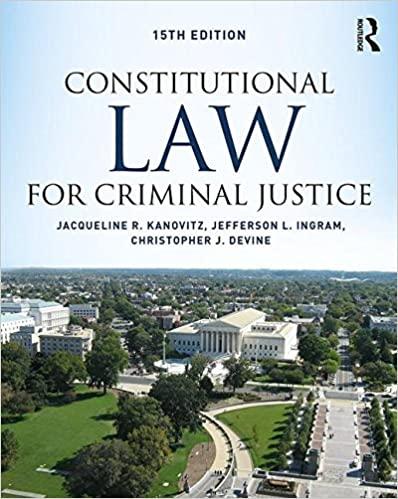Question
Please help me understand the answers to the questions, and why that answer is correct. 1.Historically, which of the followingkinds of homicide was considered to
Please help me understand the answers to the questions, and why that answer is correct.
1.Historically, which of the followingkinds of homicide was considered to be manslaughter?
a.Causing death with implied malice aforethought.
b.Causing death in the heat of passion.
c.Causing death while attempting to commit burglary.
d.Causing death through negligence.
2.A and B are law students. While engaged in a heated debate over the relative merits of originalism versuspragmatism in Constitutional interpretation, A becomesincensed and accuses B of being a traitor. B, an honorably discharged veteran,pushes A, who tumbles down the lecture hall stairs, breaks his neck, and dies.
B is charged with intentionally causing A's death. At trial, B argues that he did not act intentionally. He says he was overcome with anger and horror at A's insult and that his reaction was "impulsive" and not premeditated. At the close of trial, he asks the judge to dismiss the charges against him, arguing that no reasonable juror could find beyond a reasonable doubt that he intended to cause A's death.
How should the court rule?
a. Dismiss the charges because B only meant to push A, not kill him.
b.Dismiss the charges because B was acting in the heat of passion.
c.Deny the motion because the crime does not have an affirmative defense.
d.Deny the motion because there is sufficient evidence for conviction.
3.During a close Dean's Cupmini-golf game, 1L hits Med 1 over the head with a golf club, knocking out two of her teeth. 1L is charged with aggravated battery, which requires proof that he "intentionally caused substantial bodily harm."
If the prosecution proves that 1L intentionally swung the club at Med 1's face, which of the following is true?
a.The jury may infer that he intended to cause a "serious bodily injury" (as a natural and probable consequence of his conduct)
b.The law can constitutionally presume that his intention was to cause a "serious bodily injury" (since that is a natural and probable consequence of his conduct).
c.1L can be required to produce evidence rebutting the inference that he intended to cause substantial bodily harm.
d.None of the above.
4.State court procedural rules can bar defense evidence so long as the rules are applied neutrally and consistently to all litigants.
Group of answer choices
a.True
b.False
5.D is charged with purposely and knowingly causing the death of his best friend. He denies causing the death but also contends that, at the time of the murder, he was under the influence of drugs and has no memory of the event.
He has a right underChambersto present which of the following pieces of evidence?
a.Medical records relating to a brain injury he sustained last year
b.Testimony from two friends who say they were with him at a party across town at the time of the murder
c.Testimony from mutual friends of D and the deceased, who would testify to the strong, healthy relationship the two shared
d.All of the above
Step by Step Solution
There are 3 Steps involved in it
Step: 1

Get Instant Access to Expert-Tailored Solutions
See step-by-step solutions with expert insights and AI powered tools for academic success
Step: 2

Step: 3

Ace Your Homework with AI
Get the answers you need in no time with our AI-driven, step-by-step assistance
Get Started


